There are four main factors to consider when judging the quality and value of a diamond, commonly known as the 4cs. Gemologist experts use state-of-the-art equipment in order to evaluate all these characteristics.

Diamond Carat
It is a measure of weight. Cutting a diamond can make it look bigger or smaller than its actual weight.
One carat is equivalent to 200 milligrams and can be divided by 100 points. A diamond of 0.75 carats is the same as 75 points or 3/4 of a karat diamond.
The term carat is a derivative of the word carob. The seeds of the carob tree are surprisingly uniform in their weight, they were used as a reference for the weight of the diamond in ancient civilizations. One carob was equivalent to one carat.

When diamonds are removed, large gems are discovered much less frequently than smaller gems. Diamond prices increase exponentially with each carat.
Diamond Cut
The cut refers to the angles and proportions that an expert carver creates when transforming an unpolished diamond into a polished one. Cutting a diamond requires great skill and training. The carver aims to polish the small surfaces known as facets on the rough diamond.
Good diamond cuts
A diamond with a good cut reflects the internal light from one facet to another, scattering it on top of the stone.
The cut also refers to the shape of the diamond, the most common are the following: round (also known as brilliant cut), emerald, heart, baguette, pear, oval, and princess.

The Clarity (or Purity) of the diamond
The purity of a diamond is a measure of the presence or absence of inclusions visible, or not, to the naked eye or with a magnifying glass of 10x magnification. The lighter a diamond, the less light it deflects and the more light it reflects. These diamonds are scarcer and more valuable.
The clarity of the diamond has many significant factors that must be taken into account when certifying a diamond, for example, the size of the defect, the location, the number of defects, whether they are external or internal.
The imperfections in a diamond can be strange materials such as other crystals, air particles inside the diamond, or internal imperfections, like small cracks inside the stone. It is considerably rarer to find a perfect diamond – one that does not show any stain, line, or crack.
The inclusions of a diamond significantly influence its value, but in most cases will not disturb its beauty. They give it character and print originality.
In fact, most inclusions are not distinguished by the naked eye, you would need a magnifying glass to see the different inclusions. So, whether you buy a diamond without defects or one with very slight ones, such as a VS diamond, the appearance to the naked eye will be the same. Only for diamonds with “I” clarity or lower can you begin to appreciate the difference in brightness when compared to a “Flawless”, high purity diamond.
Therefore, in general, a diamond with VS clarity is enough to look like a high-end jewel and reflects an excellent level of quality and price.
Diamond color
The color of a diamond measures its degree of transparency and influences the beauty and price of it.

Most of the quality diamonds that are used in jewelry are colorless or almost colorless, sometimes with yellow or brown tints. Among the rarest are the colors D, E, and F on a scale that goes up to Z.
Gemological laboratories issue diamond certificates where their color grade is included. They use special equipment to compare each diamond with a “master” set of diamonds.
The gemological certificate is the best guarantee to confirm the actual color of a diamond.







